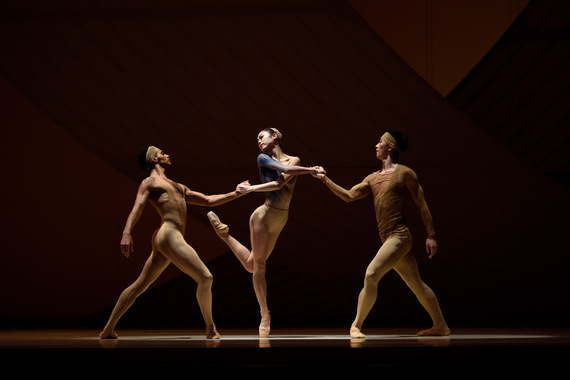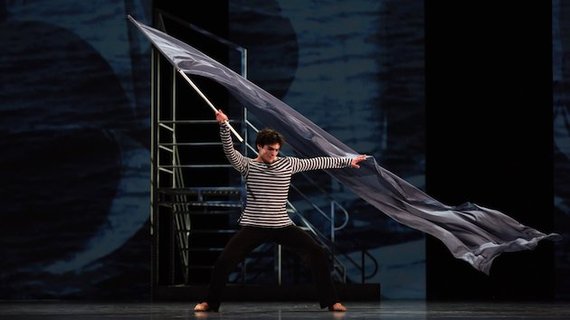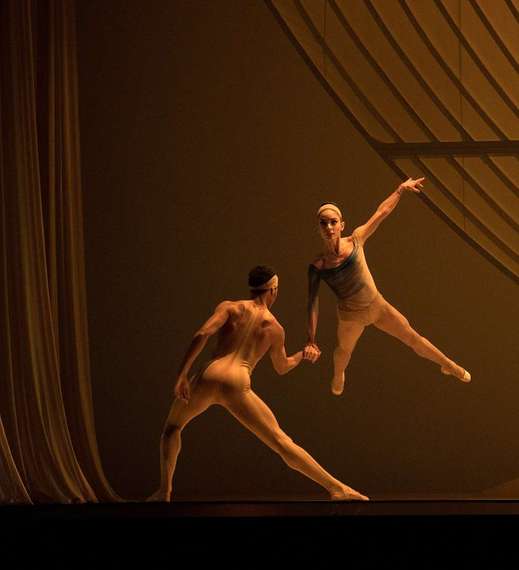It started with the best, in Program 1: Twin brothers groomed by John Neumeier's Hamburg Ballet--Jiri Bubenicek, who progressed from dancer to dance maker, and Otto Bubenicek, who became Jiri's stage designer. Their first creation for SF Ballet, Fragile Vessels, is set to Rachmaninov's well known, well loved Piano Concerto No 2, and is a master piece in modern classicism, full of emotion, grace and invention. The outstanding musicality of this choreographer translated the stirring, romantic music into controlled but fluidly shifting groupings of his 26 dancers, giving them constantly surprising, beautifully sculptural body expression.
There was none of the extreme twisting and torqueing à la William Forsythe, and yet Bubenicek achieves the same creative re-sculpting of the classical body, with bold off-balances, inward-turned counter-moves and acrobatic swing-lifts that extend to exciting landings, sometimes going right into staggered, gently syncopated collapses of bodies to the floor. It was the kind of inventive movement that you never saw coming, and nothing was overdone. The classical restraint seemed reflected in the geometric scenic arcs that extended behind and above the dancers, flooded in golden light. Particularly effective was the stop-start technique Bubenicek used, emphasizing Rachmaninov's score with moments of sudden stillness as if the dancers were listening intensely to the musical phrase. He gave the male dancers a feminine grace in their arms and flexible torsos, creating marvelous group cohesion (perhaps the title "Fragile Vessels" refers to male bodies in particular) and subtly heightening the romantic emotion of the score. 
All dancers were perfect, but Carlo di Lanno, new soloist Angelo Greco and Francisco Mungamba, partnering Jennifer Stahl, Julia Rowe and the graceful Koto Ishihara, were outstanding. The high point was the adagio: Joseph Walsh and Wei Wang in a trio with the excellently pliable Dores Andre, forming a love triangle of equally shared power and tender, spiritual openness. The trio, its theme repeated in the final movement of the concerto, exemplified what the group as a whole transmitted: a touching breath of leaning into togetherness and leaning outward apart from one another. Filled with playful casualness and light as a breath and was the ending: Walsh went into a long pirouette center stage, and the whole group of dancers rushed at him like a flock of golden-lit birds and swept him out of sight. The audience related to the new premiere with marked enthusiasm.
The second world premiere came as part of Program 2, from SF Ballet's Choreographer in Residence, Yuri Possokhov, who impressed last year with his sensitive and gripping Swimmer , a multimedia ballet based on a short story by John Cheever. His new creation, Optimistic Tragedy, was inspired by a Russian play of the same name about the Russian Revolution, and it's hard to make out what inspired the choreographer -- except the Russian theme and this year's 100th anniversary of the revolution. The ballet is a confusing parable set on a ship. Film projections of crashing waves and explosions serve as a backdrop, evoking Eisenstein's famous silent movie, Battleship Potemkin. A constructivist bridge (stage design by Alexander V. Nichols, who also designed the evocative Swimmer) looms over a deck filled with sailors. 18 men on deck, who instantly, in a lively opening scene, reveal their Russianness with Kossak dance moves, bawdy wrestles and energetic clashes, all of it in black and white like in a silent movie. But quickly the impression thickens that this 100-year anniversary came a few weeks or months too soon for Possokhov. The piece seems a muddle of grand (too grand?) ideas that remain abstractions, and the choreographic language seems overwhelmed by the orchestral clashes of the music, commissioned for the occasion by Russian composer Ilya Demutsky. 
No Dominatrix
A dark figure appears atop the bridge, the new Commissar (Lorena Feijoo), the only woman on board. In a puny black leather jacket and slit black skirt, Feijoo descends like a modernist dominatrix - but it remains a puzzle what she is doing on that ship and what her role is supposed to be. Of course she unleashes the appetites of the sailor bunch. One sailor wears a cap - he's the Captain (luke Ingham), but it's unclear whether he is in command. Another sailor strips off his shirt and lunges at her, but she won't have it: She shoots him, but that doesn't establish her authority. She is manhandled, carried around like a trophy, and swings a not exactly optimistic grey flag. She falls for the guy with the cap (talk about hierarchies within the Revolution), sliding into a long, oddly slavish love duet with him. As always, Feijoo dances with intense precision and fierce engagement, but it's puzzling to watch this slide from the dominatrix on top of the bridge to the stereotype of meaningless seduction that goes on at length and yet doesn't seem to impress her very much. Isn't there some other, more exciting male on that ship? Wait, what was that in the right corner, amidst a rowdy group in striped sailor shirts? A blitz of a dozen pirouettes with a perfect landing? Behold, it's Taras Domitro, the Cuban principal, suddenly making his mark, but if you missed the moment you might have missed him altogether in the mass. Is the woman Commissar attracted to him now? We can't be sure. Why is he part of the sailors in striped sailor shirts, while the others are dressed in white shirts? What is going on between them? 
It's always a bad sign if you have to turn to your program to find out what story you are being told. If half the men are "revolutionaries" and the others "anarchists," shouldn't there be clearly drawn differences, battle lines, distinct and telling movements for each? And a clear rivalry for the woman? The bold dancer/actress Feijoo, who is unfortunately retiring after this season, would have deserved a better role, a better story. The choreographer stymies her personality without making her a symbol of any conviction or force. Who is she then? The failed Revolution? The program tells us she is Freedom and the piece is about the value of dying for "future generations." It would have been interesting if the Commissar had been the lure of death, Madame la Mort, seducing and getting the men ready for their sacrifice. That would have made sense and brought the muddle into shape.
Possokhov almost gets there. At the end, once the Kommissar has walked off the stage, an emotional moment arises worthy of the poignant choreography in Swimmer: the men unite, are pulled together as if by a force of brotherhood and sensual closeness. Turning toward a light at the horizon, they strip off their shirts as if in a trance, and embrace as a band of brothers. Accompanied by a beautiful spiritual elevation in the music, they all sink down in a tender apotheosis of death.


